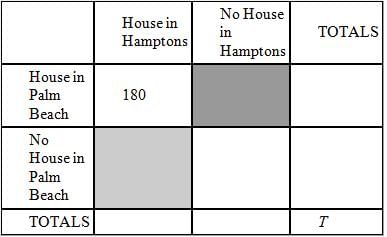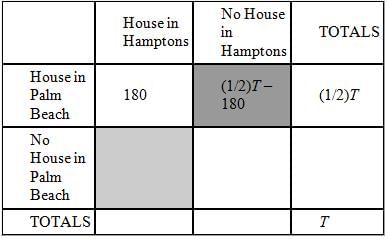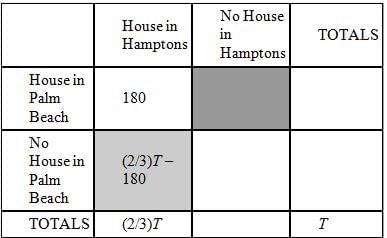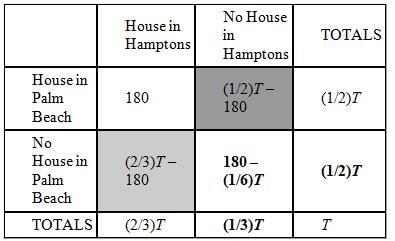GMAT Exam > GMAT Questions > At a charity fundraiser, 180 of the guests ha...
Start Learning for Free
At a charity fundraiser, 180 of the guests had a house both in the Hamptons and in Palm Beach. If not
everyone at the fundraiser had a house in either the Hamptons or Palm Beach, what is the ratio of the
number of people who had a house in Palm Beach but not in the Hamptons to the number of people who had
a house in the Hamptons but not in Palm Beach?
(1) One-half of the guests had a house in Palm Beach.
(2) Two-thirds of the guests had a house in the Hamptons
everyone at the fundraiser had a house in either the Hamptons or Palm Beach, what is the ratio of the
number of people who had a house in Palm Beach but not in the Hamptons to the number of people who had
a house in the Hamptons but not in Palm Beach?
(1) One-half of the guests had a house in Palm Beach.
(2) Two-thirds of the guests had a house in the Hamptons
- a)Statement ( 1 ) ALONE is sufficient but statement ( 2 ) alone is not sufficient.
- b)Statemrnt ( 2 ) ALONE is sufficient but statement ( 1 ) is not sufficient
- c)Both Stement TOGETHER are sufficient, but Neither statement ALONE is sufficient
- d)EACH stetement ALONE is sufficient
- e)Statement ( 1 ) and ( 2 ) TOGETHER are NOT Sufficient.
Correct answer is option 'E'. Can you explain this answer?
Verified Answer
At a charity fundraiser, 180 of the guests had a house both in the Ham...
For an overlapping set problem we can use a double-set matrix to organize our information and solve. We are told in the question stem that 180 guests have a house in the Hamptons and a house in Palm Beach. We can insert this into our matrix as follows:

The question is asking us for the ratio of the darkly shaded box to the lightly shaded box.

The question is asking us for the ratio of the darkly shaded box to the lightly shaded box.
INSUFFICIENT: Since one-half of all the guests had a house in Palm Beach, we can fill in the matrix as follows:

We cannot find the ratio of the dark box to the light box from this information alone.

We cannot find the ratio of the dark box to the light box from this information alone.
(2) INSUFFICIENT: Statement 2 tells us that two-thirds of all the guests had a house in the Hamptons. We can insert this into our matrix as follows:


We cannot find the ratio of the dark box to the light box from this information alone.
(1) AND (2) INSUFFICIENT: we can fill in our matrix as follows.

The ratio of the number of people who had a house in Palm Beach but not in the Hamptons to the number of people who had a house in the Hamptons but not in Palm Beach (i.e. dark to light) will be:


The ratio of the number of people who had a house in Palm Beach but not in the Hamptons to the number of people who had a house in the Hamptons but not in Palm Beach (i.e. dark to light) will be:

This ratio doesn’t have a constant value; it depends on the value of T. We can try to solve for T by filling out the rest of the values in the matrix (see the bold entries above); however, any equation that we would build using these values reduces to a redundant statement of T = T. This means there isn’t enough unique information to solve for T.
The correct answer is E.
Most Upvoted Answer
At a charity fundraiser, 180 of the guests had a house both in the Ham...
Given information:
- Total number of guests at the charity fundraiser = 180
- Number of guests who had a house in both the Hamptons and Palm Beach = 180
To find:
The ratio of the number of people who had a house in Palm Beach but not in the Hamptons to the number of people who had a house in the Hamptons but not in Palm Beach.
Statement 1:
One-half of the guests had a house in Palm Beach.
Statement 2:
Two-thirds of the guests had a house in the Hamptons.
Analysis:
Let's assume the number of guests who had a house in Palm Beach but not in the Hamptons is P, and the number of guests who had a house in the Hamptons but not in Palm Beach is H.
From the given information, we know that:
- P + H = 180 (since all the guests had a house in either the Hamptons or Palm Beach)
- P + 180 - H = 180 (since the number of guests who had a house in both places is 180)
Simplifying the above equations, we get:
P = H
Combining the statements:
From statement 1, we know that one-half of the guests had a house in Palm Beach. So, the number of guests who had a house in Palm Beach is 180/2 = 90.
From statement 2, we know that two-thirds of the guests had a house in the Hamptons. So, the number of guests who had a house in the Hamptons is 180*(2/3) = 120.
Since we know that P = H, the number of guests who had a house in Palm Beach but not in the Hamptons is 90 - P, and the number of guests who had a house in the Hamptons but not in Palm Beach is 120 - P.
However, we do not have any information about the value of P, so we cannot determine the ratio of these two quantities.
Conclusion:
The statements together are not sufficient to determine the ratio of the number of people who had a house in Palm Beach but not in the Hamptons to the number of people who had a house in the Hamptons but not in Palm Beach. Therefore, the correct answer is option E.
- Total number of guests at the charity fundraiser = 180
- Number of guests who had a house in both the Hamptons and Palm Beach = 180
To find:
The ratio of the number of people who had a house in Palm Beach but not in the Hamptons to the number of people who had a house in the Hamptons but not in Palm Beach.
Statement 1:
One-half of the guests had a house in Palm Beach.
Statement 2:
Two-thirds of the guests had a house in the Hamptons.
Analysis:
Let's assume the number of guests who had a house in Palm Beach but not in the Hamptons is P, and the number of guests who had a house in the Hamptons but not in Palm Beach is H.
From the given information, we know that:
- P + H = 180 (since all the guests had a house in either the Hamptons or Palm Beach)
- P + 180 - H = 180 (since the number of guests who had a house in both places is 180)
Simplifying the above equations, we get:
P = H
Combining the statements:
From statement 1, we know that one-half of the guests had a house in Palm Beach. So, the number of guests who had a house in Palm Beach is 180/2 = 90.
From statement 2, we know that two-thirds of the guests had a house in the Hamptons. So, the number of guests who had a house in the Hamptons is 180*(2/3) = 120.
Since we know that P = H, the number of guests who had a house in Palm Beach but not in the Hamptons is 90 - P, and the number of guests who had a house in the Hamptons but not in Palm Beach is 120 - P.
However, we do not have any information about the value of P, so we cannot determine the ratio of these two quantities.
Conclusion:
The statements together are not sufficient to determine the ratio of the number of people who had a house in Palm Beach but not in the Hamptons to the number of people who had a house in the Hamptons but not in Palm Beach. Therefore, the correct answer is option E.

|
Explore Courses for GMAT exam
|

|
Question Description
At a charity fundraiser, 180 of the guests had a house both in the Hamptons and in Palm Beach. If noteveryone at the fundraiser had a house in either the Hamptons or Palm Beach, what is the ratio of thenumber of people who had a house in Palm Beach but not in the Hamptons to the number of people who hada house in the Hamptons but not in Palm Beach?(1) One-half of the guests had a house in Palm Beach.(2) Two-thirds of the guests had a house in the Hamptonsa)Statement ( 1 ) ALONE is sufficient but statement ( 2 ) alone is not sufficient.b)Statemrnt ( 2 ) ALONEis sufficient but statement ( 1 ) is not sufficientc)Both Stement TOGETHER are sufficient, but Neither statement ALONE is sufficientd)EACH stetement ALONE is sufficiente)Statement ( 1 ) and ( 2 ) TOGETHER are NOT Sufficient.Correct answer is option 'E'. Can you explain this answer? for GMAT 2025 is part of GMAT preparation. The Question and answers have been prepared according to the GMAT exam syllabus. Information about At a charity fundraiser, 180 of the guests had a house both in the Hamptons and in Palm Beach. If noteveryone at the fundraiser had a house in either the Hamptons or Palm Beach, what is the ratio of thenumber of people who had a house in Palm Beach but not in the Hamptons to the number of people who hada house in the Hamptons but not in Palm Beach?(1) One-half of the guests had a house in Palm Beach.(2) Two-thirds of the guests had a house in the Hamptonsa)Statement ( 1 ) ALONE is sufficient but statement ( 2 ) alone is not sufficient.b)Statemrnt ( 2 ) ALONEis sufficient but statement ( 1 ) is not sufficientc)Both Stement TOGETHER are sufficient, but Neither statement ALONE is sufficientd)EACH stetement ALONE is sufficiente)Statement ( 1 ) and ( 2 ) TOGETHER are NOT Sufficient.Correct answer is option 'E'. Can you explain this answer? covers all topics & solutions for GMAT 2025 Exam. Find important definitions, questions, meanings, examples, exercises and tests below for At a charity fundraiser, 180 of the guests had a house both in the Hamptons and in Palm Beach. If noteveryone at the fundraiser had a house in either the Hamptons or Palm Beach, what is the ratio of thenumber of people who had a house in Palm Beach but not in the Hamptons to the number of people who hada house in the Hamptons but not in Palm Beach?(1) One-half of the guests had a house in Palm Beach.(2) Two-thirds of the guests had a house in the Hamptonsa)Statement ( 1 ) ALONE is sufficient but statement ( 2 ) alone is not sufficient.b)Statemrnt ( 2 ) ALONEis sufficient but statement ( 1 ) is not sufficientc)Both Stement TOGETHER are sufficient, but Neither statement ALONE is sufficientd)EACH stetement ALONE is sufficiente)Statement ( 1 ) and ( 2 ) TOGETHER are NOT Sufficient.Correct answer is option 'E'. Can you explain this answer?.
At a charity fundraiser, 180 of the guests had a house both in the Hamptons and in Palm Beach. If noteveryone at the fundraiser had a house in either the Hamptons or Palm Beach, what is the ratio of thenumber of people who had a house in Palm Beach but not in the Hamptons to the number of people who hada house in the Hamptons but not in Palm Beach?(1) One-half of the guests had a house in Palm Beach.(2) Two-thirds of the guests had a house in the Hamptonsa)Statement ( 1 ) ALONE is sufficient but statement ( 2 ) alone is not sufficient.b)Statemrnt ( 2 ) ALONEis sufficient but statement ( 1 ) is not sufficientc)Both Stement TOGETHER are sufficient, but Neither statement ALONE is sufficientd)EACH stetement ALONE is sufficiente)Statement ( 1 ) and ( 2 ) TOGETHER are NOT Sufficient.Correct answer is option 'E'. Can you explain this answer? for GMAT 2025 is part of GMAT preparation. The Question and answers have been prepared according to the GMAT exam syllabus. Information about At a charity fundraiser, 180 of the guests had a house both in the Hamptons and in Palm Beach. If noteveryone at the fundraiser had a house in either the Hamptons or Palm Beach, what is the ratio of thenumber of people who had a house in Palm Beach but not in the Hamptons to the number of people who hada house in the Hamptons but not in Palm Beach?(1) One-half of the guests had a house in Palm Beach.(2) Two-thirds of the guests had a house in the Hamptonsa)Statement ( 1 ) ALONE is sufficient but statement ( 2 ) alone is not sufficient.b)Statemrnt ( 2 ) ALONEis sufficient but statement ( 1 ) is not sufficientc)Both Stement TOGETHER are sufficient, but Neither statement ALONE is sufficientd)EACH stetement ALONE is sufficiente)Statement ( 1 ) and ( 2 ) TOGETHER are NOT Sufficient.Correct answer is option 'E'. Can you explain this answer? covers all topics & solutions for GMAT 2025 Exam. Find important definitions, questions, meanings, examples, exercises and tests below for At a charity fundraiser, 180 of the guests had a house both in the Hamptons and in Palm Beach. If noteveryone at the fundraiser had a house in either the Hamptons or Palm Beach, what is the ratio of thenumber of people who had a house in Palm Beach but not in the Hamptons to the number of people who hada house in the Hamptons but not in Palm Beach?(1) One-half of the guests had a house in Palm Beach.(2) Two-thirds of the guests had a house in the Hamptonsa)Statement ( 1 ) ALONE is sufficient but statement ( 2 ) alone is not sufficient.b)Statemrnt ( 2 ) ALONEis sufficient but statement ( 1 ) is not sufficientc)Both Stement TOGETHER are sufficient, but Neither statement ALONE is sufficientd)EACH stetement ALONE is sufficiente)Statement ( 1 ) and ( 2 ) TOGETHER are NOT Sufficient.Correct answer is option 'E'. Can you explain this answer?.
Solutions for At a charity fundraiser, 180 of the guests had a house both in the Hamptons and in Palm Beach. If noteveryone at the fundraiser had a house in either the Hamptons or Palm Beach, what is the ratio of thenumber of people who had a house in Palm Beach but not in the Hamptons to the number of people who hada house in the Hamptons but not in Palm Beach?(1) One-half of the guests had a house in Palm Beach.(2) Two-thirds of the guests had a house in the Hamptonsa)Statement ( 1 ) ALONE is sufficient but statement ( 2 ) alone is not sufficient.b)Statemrnt ( 2 ) ALONEis sufficient but statement ( 1 ) is not sufficientc)Both Stement TOGETHER are sufficient, but Neither statement ALONE is sufficientd)EACH stetement ALONE is sufficiente)Statement ( 1 ) and ( 2 ) TOGETHER are NOT Sufficient.Correct answer is option 'E'. Can you explain this answer? in English & in Hindi are available as part of our courses for GMAT.
Download more important topics, notes, lectures and mock test series for GMAT Exam by signing up for free.
Here you can find the meaning of At a charity fundraiser, 180 of the guests had a house both in the Hamptons and in Palm Beach. If noteveryone at the fundraiser had a house in either the Hamptons or Palm Beach, what is the ratio of thenumber of people who had a house in Palm Beach but not in the Hamptons to the number of people who hada house in the Hamptons but not in Palm Beach?(1) One-half of the guests had a house in Palm Beach.(2) Two-thirds of the guests had a house in the Hamptonsa)Statement ( 1 ) ALONE is sufficient but statement ( 2 ) alone is not sufficient.b)Statemrnt ( 2 ) ALONEis sufficient but statement ( 1 ) is not sufficientc)Both Stement TOGETHER are sufficient, but Neither statement ALONE is sufficientd)EACH stetement ALONE is sufficiente)Statement ( 1 ) and ( 2 ) TOGETHER are NOT Sufficient.Correct answer is option 'E'. Can you explain this answer? defined & explained in the simplest way possible. Besides giving the explanation of
At a charity fundraiser, 180 of the guests had a house both in the Hamptons and in Palm Beach. If noteveryone at the fundraiser had a house in either the Hamptons or Palm Beach, what is the ratio of thenumber of people who had a house in Palm Beach but not in the Hamptons to the number of people who hada house in the Hamptons but not in Palm Beach?(1) One-half of the guests had a house in Palm Beach.(2) Two-thirds of the guests had a house in the Hamptonsa)Statement ( 1 ) ALONE is sufficient but statement ( 2 ) alone is not sufficient.b)Statemrnt ( 2 ) ALONEis sufficient but statement ( 1 ) is not sufficientc)Both Stement TOGETHER are sufficient, but Neither statement ALONE is sufficientd)EACH stetement ALONE is sufficiente)Statement ( 1 ) and ( 2 ) TOGETHER are NOT Sufficient.Correct answer is option 'E'. Can you explain this answer?, a detailed solution for At a charity fundraiser, 180 of the guests had a house both in the Hamptons and in Palm Beach. If noteveryone at the fundraiser had a house in either the Hamptons or Palm Beach, what is the ratio of thenumber of people who had a house in Palm Beach but not in the Hamptons to the number of people who hada house in the Hamptons but not in Palm Beach?(1) One-half of the guests had a house in Palm Beach.(2) Two-thirds of the guests had a house in the Hamptonsa)Statement ( 1 ) ALONE is sufficient but statement ( 2 ) alone is not sufficient.b)Statemrnt ( 2 ) ALONEis sufficient but statement ( 1 ) is not sufficientc)Both Stement TOGETHER are sufficient, but Neither statement ALONE is sufficientd)EACH stetement ALONE is sufficiente)Statement ( 1 ) and ( 2 ) TOGETHER are NOT Sufficient.Correct answer is option 'E'. Can you explain this answer? has been provided alongside types of At a charity fundraiser, 180 of the guests had a house both in the Hamptons and in Palm Beach. If noteveryone at the fundraiser had a house in either the Hamptons or Palm Beach, what is the ratio of thenumber of people who had a house in Palm Beach but not in the Hamptons to the number of people who hada house in the Hamptons but not in Palm Beach?(1) One-half of the guests had a house in Palm Beach.(2) Two-thirds of the guests had a house in the Hamptonsa)Statement ( 1 ) ALONE is sufficient but statement ( 2 ) alone is not sufficient.b)Statemrnt ( 2 ) ALONEis sufficient but statement ( 1 ) is not sufficientc)Both Stement TOGETHER are sufficient, but Neither statement ALONE is sufficientd)EACH stetement ALONE is sufficiente)Statement ( 1 ) and ( 2 ) TOGETHER are NOT Sufficient.Correct answer is option 'E'. Can you explain this answer? theory, EduRev gives you an
ample number of questions to practice At a charity fundraiser, 180 of the guests had a house both in the Hamptons and in Palm Beach. If noteveryone at the fundraiser had a house in either the Hamptons or Palm Beach, what is the ratio of thenumber of people who had a house in Palm Beach but not in the Hamptons to the number of people who hada house in the Hamptons but not in Palm Beach?(1) One-half of the guests had a house in Palm Beach.(2) Two-thirds of the guests had a house in the Hamptonsa)Statement ( 1 ) ALONE is sufficient but statement ( 2 ) alone is not sufficient.b)Statemrnt ( 2 ) ALONEis sufficient but statement ( 1 ) is not sufficientc)Both Stement TOGETHER are sufficient, but Neither statement ALONE is sufficientd)EACH stetement ALONE is sufficiente)Statement ( 1 ) and ( 2 ) TOGETHER are NOT Sufficient.Correct answer is option 'E'. Can you explain this answer? tests, examples and also practice GMAT tests.

|
Explore Courses for GMAT exam
|

|
Signup for Free!
Signup to see your scores go up within 7 days! Learn & Practice with 1000+ FREE Notes, Videos & Tests.























